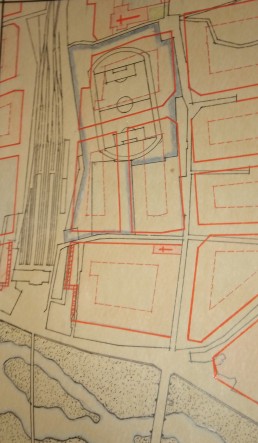In 1952, Levante U.D. was immersed in a series of unwanted turbulences, caused by the fact that it was the lessee and not the owner of the possessions related to the Vallejo Stadium
In the summer months of the same year, Don Antonio Lledó Sanchez acted on behalf of the interests of Doña Ana Martínez de Vallejo y Morand, as well as Doña María Manglano Cucaló de Montull, heirs of the properties located between the Convent of San Cristóbal and the Parroquia del Carmen. In order 215 of the current year, the legal representative of the Martínez de Vallejo y Manglano family formally requested the eviction of the Levantine entity due to circumstances related to the lack of payment.
By way of evidence, the plaintiff decided to offer the Partial Plan nº10 of urban alignments in which the extension occupied by the Vallejo Sports Ground, of which Levante U.D. makes use and enjoyment. Said plan-croquis, shows in blue the area comprised by the Vallejo Ground, while in red the alignments of the urban fabric affecting the sports ground itself are indicated.
In the certifications of the Municipal Town Planning architect on the validity of the alignments shown in section plan nº10, it is specified that the total area occupied by the sports area is 28,926 square metres, of which 20,846 square metres are suitable for building, while the remaining 8,082 square metres correspond to public roads. This same idea was ratified on 17 November of the same year, at which time the main architect stated that the plan-croquis, which was approved on 18 December 1946, as well as the plans of the widening of the area, showed that the block occupied by the Vallejo Sports Ground, as well as other areas of land, were destined to become a building area. Levante U.D. was involved in two different difficulties that affected the club in the same way: the eviction of Vallejo. The first of the aforementioned problems is the private interests of the Martínez de Vallejo y Manglano family, caused by the lack of payments inherited to date; the second corresponds to a notorious interest on the part of the council in reorganising the urban fabric, with the aim of urbanising and building on the Vallejo plots, at the risk of causing great damage to the council’s coffers if this is not carried out.
Antonio Román, president of the entity still located in Vallejo, had to determine a clear strategy in order to cancel this departure, which could mean the total disappearance of the club. The manoeuvre outlined by the president was based on two actions with a certain continuity: the first was to revoke the eviction order, with the aim of finding a possible solution; the second, the acquisition of the Vallejo space, for an amount of around six million pesetas.
